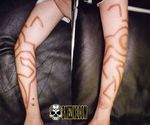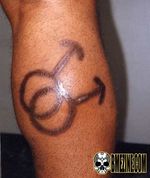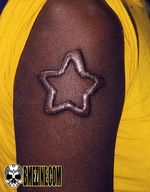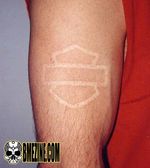Brand
Branding is scarification, usually through the application of a heated material (usually metal) to the skin, making a serious burn that eventually becomes a scar. Ideally, a healed branding looks like a pattern of thick raised lines, slightly lighter than skin color (when fully healed). However, the amount of raising or keloiding varies greatly, dependent on a large number of factors. Sometimes they even inset rather than raise.
Scarification operates through controlled injury. It is not safe. That said, many things we do every day are not safe either. Practised responsibly by experienced practitioners, scarification of all kinds should fall inside "acceptable risk."
Procedure
There are many ways to branding. The traditional way is strike branding, but new forms like electrocautery, electrosurgery branding (also known as laser branding). Some people also brand with a hand held cautery pen.
Healing and Aftercare
A brand takes a long time to heal. It will probably look very scary for a while. Brands go through a few phases of healing, which differ in length from brand to brand a great deal.
Longterm Health Issues
It should be noted that recent studies have been started around the safety of vapors given off during the use of surgical cauteries. You see, doctors removing genital warts were ending up with the exact same warts forming in their sinuses due to the inhalation of the vapors!
Tattoos
Brandings can be tattooed over, but the scar has to be WELL HEALED (in generally, at least a year old). Assuming that the scar is well healed, it should be able to hold ink just as well as "normal" skin.
Removal
In theory, a cosmetic surgeon can remove a brand using lasers and other advanced techniques, but it will be very expensive and not necessarily effective. Don't get a brand if you don't want one—it's a serious burn resulting in a serious burn scar, and must be removed as such.
History
Historically (in Europe), branding was generally limited to punishment. Both the English (with an S on the cheek) and the French (with a fleur de lis on the shoulder) branded criminals, along with almost every other culture.
Cold Branding
A very small number of people have experimented with cold branding using liquid nitrogen.
Procedure
The actual procedure is surprisingly similar to strike branding. Instead of immersing the (often copper) iron into the heat of a propane torch, the iron is bathed in a solution of liquid nitrogen.





